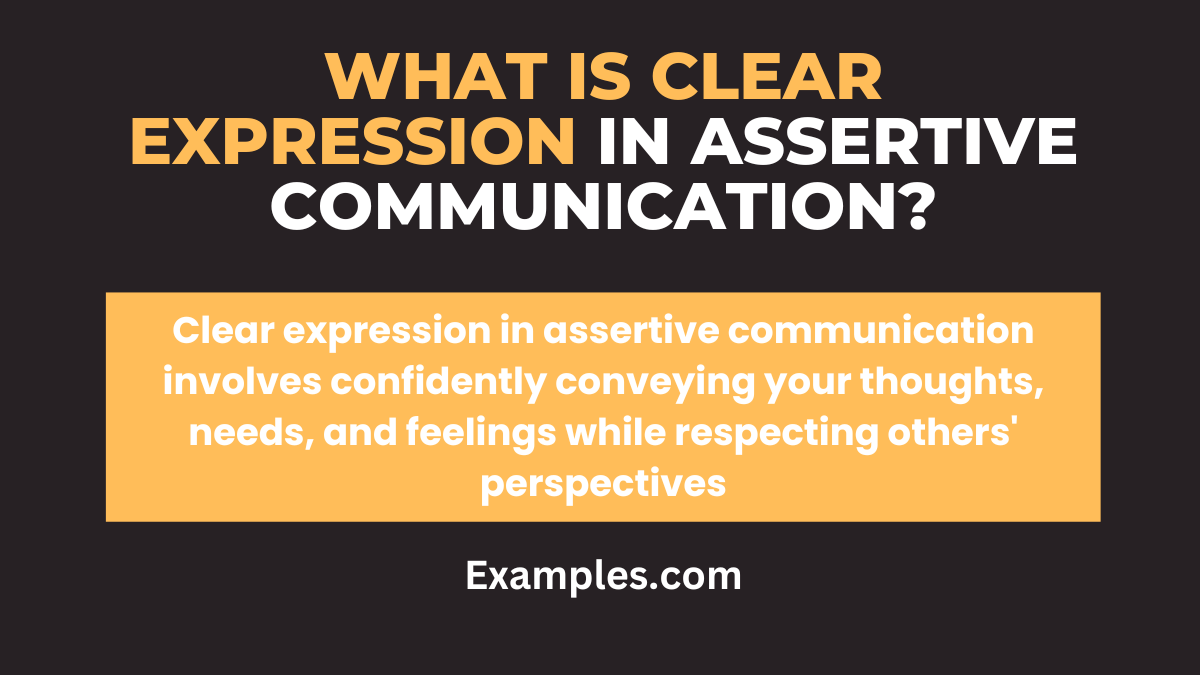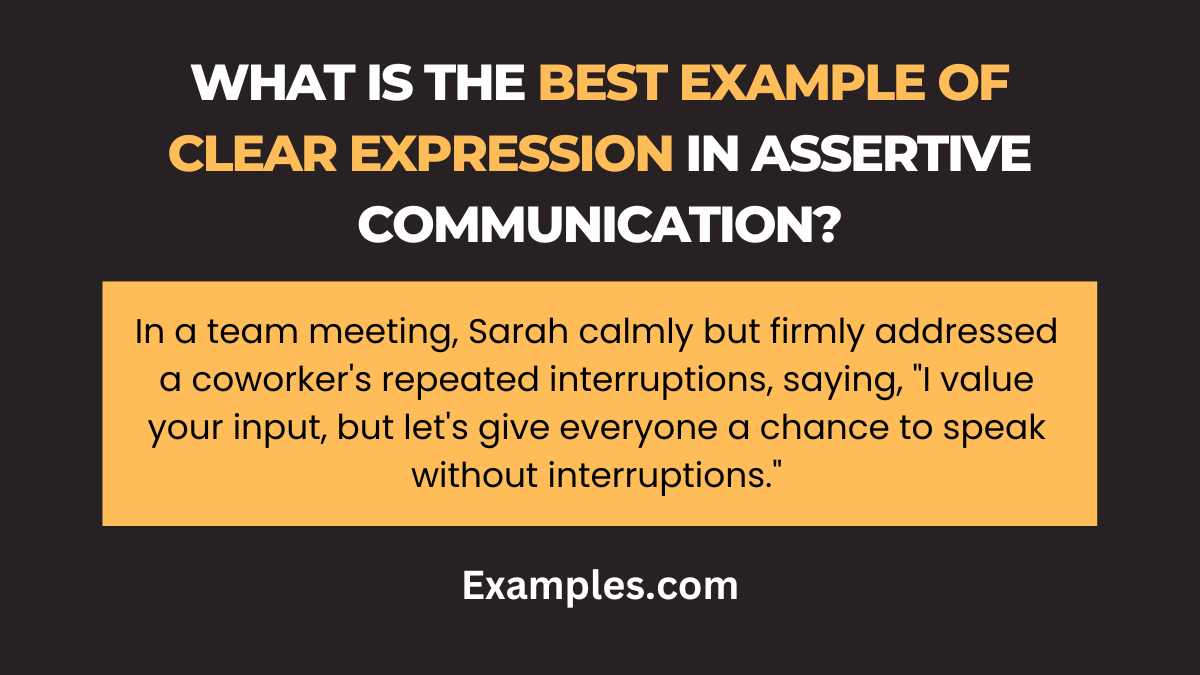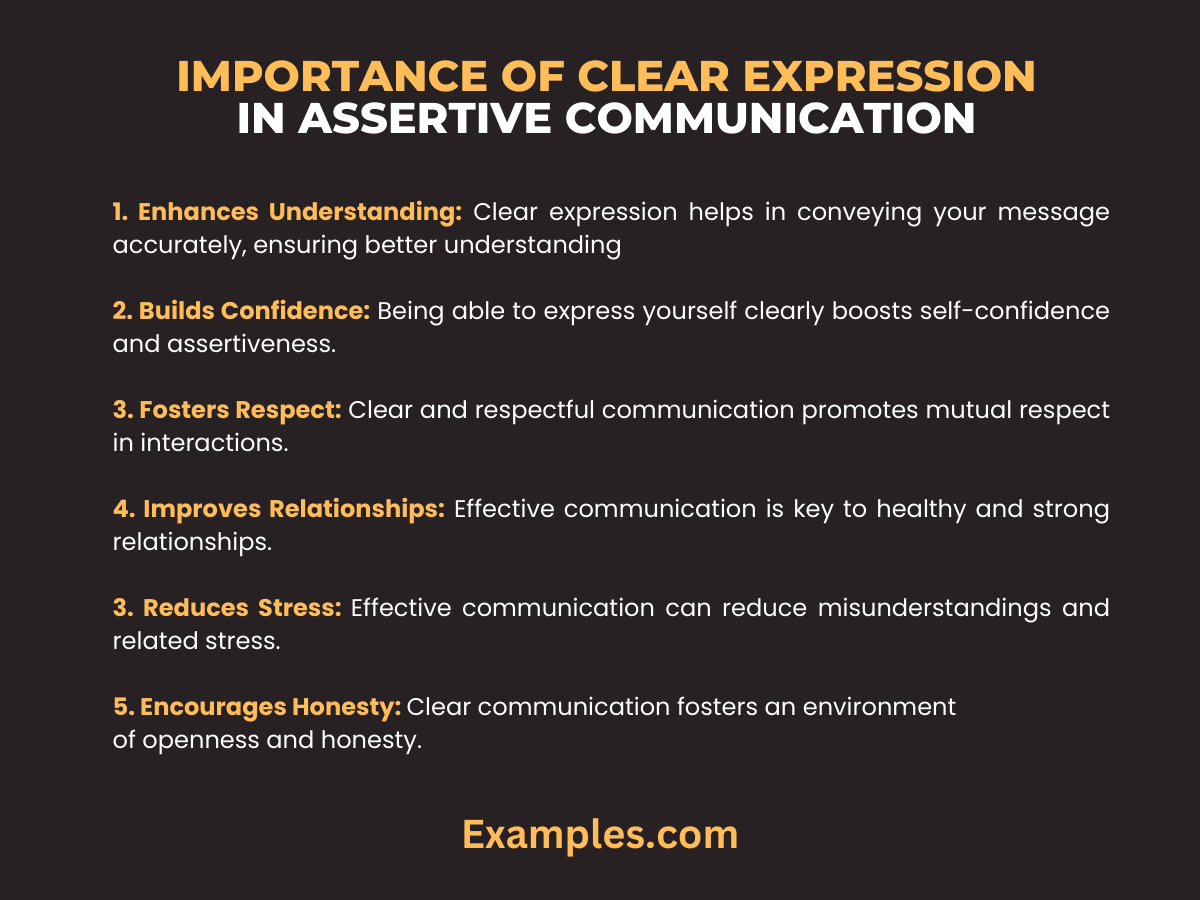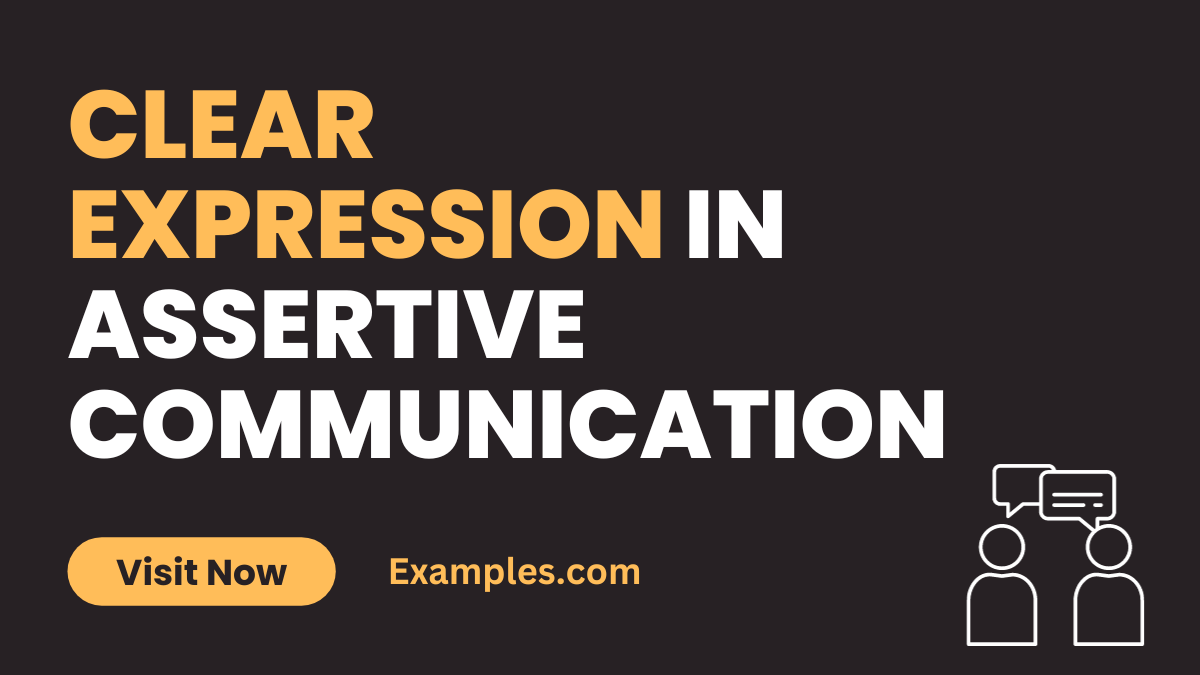19+ Clear Expression in Assertive Communication Examples
Assertive communication is pivotal in establishing strong interpersonal relationships, both personally and professionally. Mastering the art of Clear Expression in Assertive Communication is not just about being heard but also about respecting others’ perspectives. This guide delves into the essence of clear and assertive expression, offering invaluable insights and practical tips to enhance your communication skills. Embrace the journey towards becoming a more effective and empathetic communicator.
What is Clear Expression in Assertive Communication?

Clear expression in assertive communication refers to the ability to express your thoughts, feelings, and needs directly, honestly, and respectfully. It involves using I Statements in Assertive Communication to articulate your perspective without being aggressive or passive. This approach fosters understanding and respect, making it a cornerstone in effective interpersonal interactions.
What is the Best Example of Clear Expression in Assertive Communication?

A prime example of clear expression in assertive communication is when an individual addresses a concern with a colleague. Instead of being accusatory, they use phrases like, “I feel concerned when deadlines are missed because it affects our team’s performance. Can we discuss a solution?” This example showcases the use of Empathy in Assertive Communication, where the speaker acknowledges their feelings and the situation’s impact, paving the way for constructive dialogue and mutual understanding
20 Examples Clear Expression in Assertive Communication
Clear expression is a pivotal component in Assertive Communication Skills, involving conveying thoughts and feelings directly and respectfully. Mastering Clear Expression in Assertive Communication enhances understanding and reduces misunderstandings, making it essential for effective interpersonal interactions. It involves straightforward language, active listening, and empathy, facilitating a balanced exchange of ideas and emotions.
- “I feel overwhelmed when I have too many tasks. Can we discuss prioritizing them?” Explains personal feelings without blaming others, promoting a solution-oriented conversation.
- “I appreciate your perspective, but I see things differently. Let’s find common ground.” Respectfully acknowledges differences, encouraging collaborative problem-solving.
- “I need some time alone to recharge. Let’s reconnect later.” Expresses personal needs clearly, setting healthy boundaries.
- “I am not comfortable with this decision. Can we explore other options?” Directly addresses discomfort, inviting further discussion.
- “I value your input, but I must make my own choice in this matter.” Asserts independence while respecting others’ opinions.
- “I understand your point, but I disagree for these reasons…” Balances understanding and disagreement, fostering open dialogue.
- “I feel unheard in our conversations. Can we work on our communication style?” Highlights personal feelings, aiming to improve mutual understanding.
- “I need more information to understand your viewpoint better.” Seeks clarity, enhancing mutual comprehension.
- “I can see both sides, but here’s what I think…” Demonstrates empathy and clear personal stance.
- “I am not ready to discuss this now. Can we talk about it later?” Sets a boundary while keeping the communication open for future.
- “I appreciate your help, but I would prefer doing this task my way.” Politely declines assistance, asserting personal work preference.
- “I am committed to finishing this project, despite the challenges.” Expresses determination and commitment, reinforcing a positive attitude.
- “I feel frustrated when meetings start late. Can we start on time?” Clearly states an issue and suggests a practical solution.
- “I need your support on this project to succeed.” Directly communicates the need for assistance, promoting teamwork.
- “I respect your decision, but I will take a different approach.” Acknowledges others’ choices while asserting one’s own path.
- “I hear what you’re saying, but here’s another perspective…” Validates others’ viewpoints before presenting an alternative.
- “I would like to talk about how we can improve our workflow.” Initiates constructive conversation focused on improvement.
- “I am not sure I agree. Can you explain further?” Expresses uncertainty, seeking more information for clarity.
- “I find your approach interesting. Here’s my take on it.” Shows interest in others’ ideas before sharing personal thoughts.
- “I feel valued when my contributions are acknowledged.” Shares feelings about recognition, encouraging positive feedback.
Importance of Clear Expression in Assertive Communication

- Enhances Understanding: Clear expression helps in conveying your message accurately, ensuring better understanding.
- Builds Confidence: Being able to express yourself clearly boosts self-confidence and assertiveness.
- Fosters Respect: Clear and respectful communication promotes mutual respect in interactions.
- Improves Relationships: Effective communication is key to healthy and strong relationships.
- Facilitates Problem-Solving: Clear expression is crucial in resolving conflicts and finding solutions.
- Reduces Stress: Effective communication can reduce misunderstandings and related stress.
- Encourages Honesty: Clear communication fosters an environment of openness and honesty.
- Promotes Effective Feedback: Clarity in expression is essential for giving and receiving constructive feedback.
- Aids in Decision Making: Clear communication helps in making informed and thoughtful decisions.
- Supports Personal Growth: Developing clear communication skills contributes to personal and professional growth.
Tips to Improve Clear Expression in Assertive Communication
- Practice Active Listening: Engage fully in conversations by listening attentively, demonstrating understanding, and responding appropriately.
- Use ‘I’ Statements: Start sentences with ‘I’ to express your feelings or thoughts without blaming others.
- Be Specific and Direct: Clearly articulate your needs and desires without ambiguity.
- Maintain a Respectful Tone: Ensure your tone is polite and considerate, even when discussing difficult issues.
- Develop Empathy: Show understanding and consideration for others’ feelings and perspectives.
- Use Appropriate Body Language: Employ non-verbal cues that are open and confident, complementing your verbal messages.
- Manage Emotions Effectively: Keep your emotions in check to maintain clarity and avoid misunderstandings.
- Provide Constructive Feedback: Offer feedback that is helpful and focused on improvement.
- Set Clear Boundaries: Communicate your limits firmly but respectfully.
- Learn Conflict Resolution Skills: Develop strategies to handle disagreements constructively and diplomatically.
In conclusion, mastering Clear Expression in Assertive Communication is not only about articulating your thoughts but also about engaging in active, empathetic listening and being mindful of nonverbal cues. As the Mayo Clinic highlights, assertive communication is a balanced approach that respects both your own rights and those of others, aiding in conflict resolution and building self-esteem????. Harvard DCE’s Professional Development Blog further emphasizes the importance of clarity, brevity, and active listening in effective communication. Being clear and concise ensures that your message is understood, while being attentive to nonverbal signals and practicing active listening leads to more meaningful and productive interactions??.
For more insights on enhancing assertive communication, consider exploring the Mayo Clinic’s guidelines on assertive communication, which offer practical advice on how to express yourself effectively and respectfully (Mayo Clinic – Assertive Communication). Additionally, Harvard DCE’s blog on improving communication skills provides valuable strategies for clear and impactful communication in professional settings (Harvard DCE – Communication Skills).



